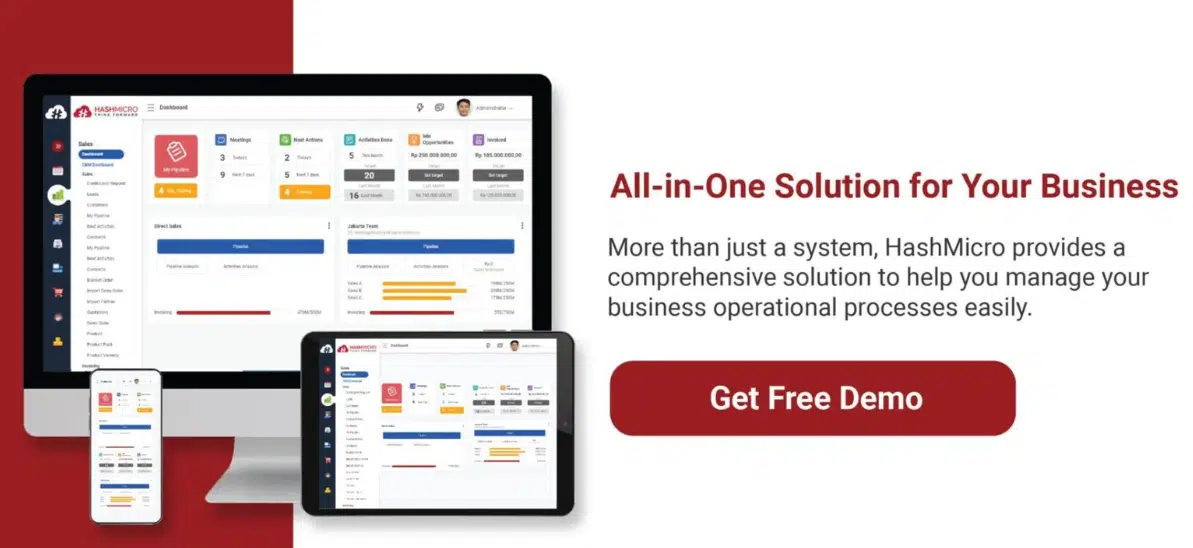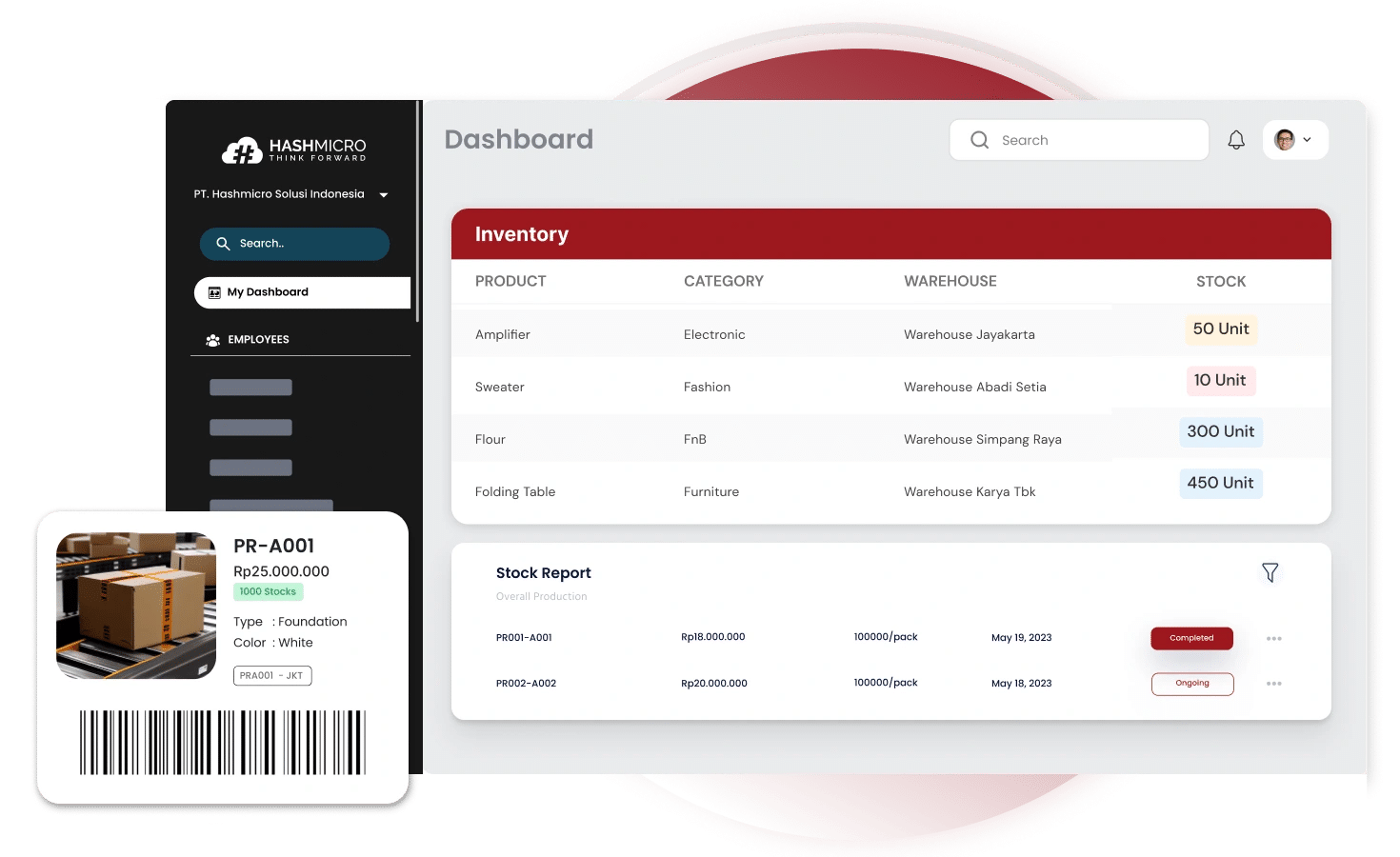Inventory management system can efficiently track, control, and optimize inventory levels across various stages from procurement to sales, enhancing operational efficiency and reducing costs.
It allows companies to streamline their order processes and optimize stock control for better cost of sales efficiency. With an effective inventory management system in place, businesses can ensure that they have the right products in the right quantities at the right time.
There are different types of inventory management software available, each with its own features and functionalities. From spreadsheet-based systems to cloud-based solutions, businesses can choose the system that best suits their specific needs and requirements.
In this article, we will dive deeper into the definition of an inventory management system, explore its benefits, discuss the different types available, and highlight the key features that make these systems effective in managing inventory.
So, if you want to learn more about inventory management systems and how they can benefit your business in Singapore, keep reading.
Table of Content:
Table of Content
Key Takeaways
|
What is an Inventory Management System?
An inventory management system, also known as an inventory system, is a process that tracks and manages goods throughout the entire supply chain, from purchasing to production to end sales. It helps businesses approach inventory management efficiently by ensuring optimal stock levels while minimizing carrying costs.
Meanwhile, an inventory control system is a technological tool designed to oversee and monitor a company’s goods throughout the supply chain. This system integrates and oversees purchasing, shipping, receiving, warehousing, and returns within a unified framework.
A top-notch inventory control system streamlines numerous manual tasks by automation. It offers precise insights into available inventory, and its location, and prompts reorder notifications to maintain optimal stock levels.
Different types of inventory management techniques can be used within an inventory management system to optimize inventory control. Some advanced techniques include Just-in-Time (JIT) inventory, ABC analysis, and the FIFO (First-In, First-Out) and LIFO (Last-In, First-Out) methods.
Advanced Inventory Management Techniques
1. Just-in-Time (JIT) inventory: This method reduces excess inventory by ordering supplies only when needed, improving efficiency and cutting costs.
2. ABC analysis: This technique categorizes inventory based on its value and importance, helping businesses focus resources on the most valuable items.
3. FIFO/LIFO methods: FIFO (First-In, First-Out) sells the oldest items first, while LIFO (Last-In, First-Out) sells the newest first. These methods help businesses track inventory and calculate costs.
Understanding these advanced techniques can help businesses make informed decisions when it comes to managing their inventory effectively.
In Singapore’s fast-moving business landscape, where efficiency and accuracy are key, relying on outdated tools can slow things down. Yet, many businesses still use spreadsheets to manage their inventory—even though they often lead to errors, delays, and missed opportunities.
Spreadsheets Can’t Keep Up with the Needs of Modern Inventory Management
Spreadsheets, though familiar, cannot meet the demands of today’s advanced inventory management needs. Their static nature and reliance on manual data entry makes them prone to errors and delays, preventing accurate inventory tracking and decision-making.
Unlike specialized inventory management systems, spreadsheets lack real-time visibility into inventory movements and lack integration with advanced technologies such as barcode scanning and RFID.
As businesses grow and face increased complexity in their supply chains, the limitations of spreadsheets become more apparent, leading to inefficiencies and challenges in maintaining accurate records across multiple locations.
Adopting specialized inventory management software enables businesses to improve accuracy, streamline operations, and increase responsiveness to market dynamics, thereby gaining a competitive edge in effectively managing their inventory.
How Does Inventory Management System Work?
An inventory management system plays a crucial role in the efficient operation of businesses. But how does it actually work? Let’s explore the inner workings of an inventory management system and its impact on order processes, stock control, and the supply chain.
1. Automates stock updates by tracking inventory in real time, from purchases to sales and returns. This reduces manual work, minimizes errors, and keeps inventory records accurate. Businesses can also monitor stock levels across multiple locations easily.
2. Optimizes order processes by sending alerts when stock is low. This ensures businesses can reorder on time, preventing stockouts and lost sales. At the same time, it helps avoid overstocking, which saves storage space and reduces costs.
3. Improves stock control by ensuring businesses maintain the right amount of inventory based on demand. This prevents expired or obsolete stock and helps businesses avoid unnecessary costs.
4. Enhances supply chain visibility by tracking inventory movements from suppliers to customers. Businesses can spot inefficiencies, avoid delays, and work better with suppliers to ensure smooth operations.
5. Integrates with other business tools like accounting, sales, and production systems. This helps businesses keep financial records accurate, update stock levels in real time, and plan production more effectively.
With the help of an inventory management system, businesses can achieve efficiency, cost savings, and a competitive edge in today’s dynamic business environment.
Why do You Need an Inventory Management System?
Implementing an inventory management system is essential for any business that deals with stock. Without an efficient system in place, businesses may face overstocking or understocking issues, leading to financial losses and customer dissatisfaction. An inventory management system provides several benefits that address these issues.
- Greater Inventory Visibility: An inventory management system offers greater inventory visibility, allowing businesses to track stock levels, locations, and reorder points accurately. This ensures that businesses can meet customer demand, reducing stockouts and improving customer service.
- Profitability Insights: An inventory management system helps businesses understand their profitability by recording and analyzing inventory data. This enables them to determine the value of their inventory and make informed decisions about pricing and profitability.
- Workflow Efficiency: An inventory management system improves workflow efficiency by automating manual tasks and providing real-time information. This streamlines processes and allows businesses to operate more smoothly and effectively.
- Accurate Financial Reporting: An inventory management system supports accurate financial reporting by accurately accounting for inventory. This ensures that businesses have reliable data for financial analysis, reporting, and decision-making.
Overall, an inventory management system is vital for businesses to optimize their stock management, meet customer demand, improve profitability, enhance workflow efficiency, and ensure accurate financial reporting.
Types of Inventory Management System
When it comes to managing inventory, businesses have various types of inventory management systems to choose from. Each type offers unique features and functionalities to address different inventory management needs. Let’s explore the different types of inventory management systems to help you make an informed decision for your business.
Spreadsheet-based inventory management system
A spreadsheet-based inventory management system utilizes tools like Excel or Google Sheets to track and manage inventory. This type of system is affordable and easy to set up. However, it has limitations. As businesses grow in complexity, relying solely on spreadsheets can lead to human errors, lack of flexibility, and reduced accuracy.
Automated inventory management system
An automated inventory management system is specifically designed to streamline the process of tracking and controlling stock. By automating administrative tasks and providing real-time visibility, this system improves accuracy, reduces errors, and optimizes operational processes. Implementing an automated system can save time and resources, allowing businesses to focus on strategic decision-making.
Warehouse management system
A warehouse management system (WMS) focuses on organizing, managing, and optimizing storage facilities. It equips warehouse teams with the tools needed to efficiently handle and track goods within a warehouse. A WMS enhances inventory control, reduces errors, and improves productivity in warehouse operations.
3PL inventory management system
A 3PL (Third-Party Logistics) inventory management system is essential for optimizing the storage and handling of goods for multiple clients across various locations.
These systems offer real-time visibility into inventory levels, automate tracking with technologies like barcode scanning and RFID, and integrate seamlessly with other business software such as WMS, TMS, and ERP systems.
This integration ensures efficient information flow, supports accurate forecasting and replenishment, and provides valuable insights through robust reporting and analytics tools. Key features of a 3PL inventory system include:
- Instant inventory monitoring
- Management of inventory across multiple warehouses
- Omnichannel order fulfillment
- Returns handling
- Backorder coordination
- Integration with eCommerce and CRM systems
ERP inventory management system
An enterprise resource planning (ERP) inventory management system integrates inventory management with other business processes, such as accounting and production. This comprehensive system provides a centralized solution for managing inventory and enables seamless coordination across departments. With an ERP system, businesses can streamline operations, improve data accuracy, and optimize inventory control.
Cloud-based inventory management system
A cloud-based inventory management system offers the advantages of accessibility, scalability, and real-time data. This type of system allows businesses to access their cloud-based inventory data from anywhere and at any time, as long as there is an internet connection. Cloud based inventory systems also enable integration with other cloud applications, ensuring a seamless flow of information and enhancing overall efficiency.
Choosing the right type of inventory management system depends on your specific business needs and the complexity of your operations. Consider factors such as scalability, flexibility, and integration capabilities when making your decision. Now that we’ve explored the different types of inventory management systems, let’s move on to the features that make these systems effective in managing inventory.
Need to Know
Periodic vs Perpetual Inventory Systems
When managing inventory, businesses often choose between periodic inventory system and perpetual inventory systems. Each has its distinct methods and advantages.
| Periodic Inventory System | Perpetual inventory system |
|
|
While it requires a higher investment in technology and is more complex to manage, it benefits businesses with high inventory turnover by providing better control and responsiveness to demand changes.
Choosing between these systems depends on a business’s size, resources, and operational needs. Periodic systems are suited for smaller businesses with slower turnover, while perpetual systems are advantageous for those seeking real-time insights and greater efficiency.
What are The Features of an Inventory Management System?
An effective inventory management system provides businesses with various features that enable them to efficiently manage their inventory. These features are designed to streamline processes, improve visibility, and optimize stock control. Let’s explore some of the key features:
1. Live inventory tracking: Critical feature that offers real-time visibility into inventory levels, locations, and stock movements. With this feature, businesses can accurately track and monitor their inventory, enabling them to make informed decisions about stock ordering, production, and sales.
2. Procurement management: Helps businesses streamline the purchasing process by ensuring that the right inventory is acquired at the right time. By automating procurement tasks and optimizing supply chain processes, businesses can avoid stockouts and maintain optimal inventory levels.
3. Barcode scanning: Allowing businesses to quickly and accurately scan and record stock data. With this feature, businesses can easily identify and track items, streamline stocktaking processes, and reduce human errors associated with manual data entry.
4. Cloud integrations: Enable seamless connectivity between the inventory management system and other business applications, such as accounting and sales platforms. This ensures that inventory data is synchronized and up to date across all systems, leading to improved operational efficiency and accuracy.
5. Inventory reporting: Provides businesses with insights and analytics on stock levels, sales performance, and profitability. These reports help businesses identify trends, make data-driven decisions, and optimize inventory management strategies for better business outcomes.
With these features, an inventory management system empowers businesses to optimize their stock control, streamline processes, and improve overall operational performance.
Level Up Your Inventory Management for Maximum Efficiency
Embarking on a journey with a dedicated inventory solution can be a game-changer for your enterprise, marking a significant evolution in how you operate. Here are some telltale indicators that it’s time for an upgrade.
Craving More Flexibility?
The rigid confines of spreadsheet inventory management can stifle your operational flow. If you’re constantly adding new sheets to keep up or facing hurdles because your team can’t access up-to-the-minute data, it’s a clear sign that a leap to cloud-based inventory software could be your next smart move.
Seeking Pinpoint Accuracy?
Ever feel like keeping track of your stock levels is more guesswork than science? With a specialized solution, both you and your team can tap into current inventory stats anytime, anywhere, ensuring you’re always in the know.
Rising Inventory Costs Weighing You Down?
Escalating holding costs can quietly eat away at your profits if left unchecked. The secret to trimming down those costs lies in storing just the right amount of stock. A streamlined inventory management system is your ally in maintaining optimal storage efficiency.
Is Your Growth Hitting a Snag?
When your sales team is playing phone tag with the stockroom to know what’s on hand, or you’re bogged down with manual report writing instead of engaging with customers, it’s a signal that your stock might be mismanaged. Switching to dedicated software can be the catalyst for reigniting your growth trajectory.
The Best Inventory Management System Recommendation in Singapore
Choosing the right inventory management system is important to maintain the business process. In Singapore, there are lots of the best inventory management systems in the market, some of them are:
-
HashMicro Inventory Software: A user-friendly system that simplifies inventory management with real-time tracking, automation, and seamless integration with other business functions like accounting and CRM. Perfect for businesses of all sizes.
-
Zoho Inventory: Cloud-based, easy-to-use, and integrates well with other Zoho products, ideal for small to medium-sized businesses.
-
Fishbowl: Advanced inventory features like barcode scanning and automatic reordering, suitable for larger businesses.
-
inFlow Inventory: Flexible and user-friendly, offering stock management, orders, and powerful reporting tools.
-
Lightspeed Retail: POS and inventory management for retail businesses, providing seamless stock tracking and purchase order management.
-
Netstock: Optimizes inventory with demand forecasting and minimizes stock issues, great for complex inventory needs.
-
NetSuite: A comprehensive ERP system with robust inventory management for large businesses, covering all aspects of operations.
For more information about the overall software abilities and the pros cons, you can read the complete Singapore inventory management software recommendations.
Conclusion
So, in a nutshell, an inventory management system is designed to help businesses automate their inventory management, whether the inventory is the company’s assets or merchandise.
Inventory management systems are not only used by large companies but also by small and medium businesses. Cloud-based inventory management software is usually the preferred option for SMEs because of its more affordable price, easier implementation, and better flexibility.
HashMicro provides customizable inventory management software regarding the needs of each unique business. HashMicro also provides free consultation for those who plan to automate their inventory operations. Try the free demo now for an instant experience.

FAQ About Inventory Management System
What is ERP System?
An inventory management system combines technology (hardware and software) and processes and procedures that oversee the company’s monitoring and maintenance of products stocked. These products can be company assets, raw materials, or finished products ready to be sent to vendors or end consumers.What are the benefits of inventory management system?
With an inventory management system, you can find out the availability of your items and find their location in just seconds, even if they are put in different warehouses or stores. You can also process orders and track couriers through the same system.Which inventory method is best?
The best inventory method depends on a business’s needs. FIFO (First-In, First-Out) is ideal for perishable goods, ensuring older stock is sold first. LIFO (Last-In, First-Out) works well for businesses facing rising costs, as it reduces taxable income. Weighted Average Cost (WAC) smooths out price fluctuations by averaging costs, while Just-in-Time (JIT) minimizes holding costs by ordering stock only when needed. Choosing the right method depends on factors like industry, cash flow, and tax implications.





































